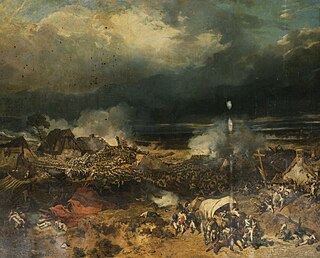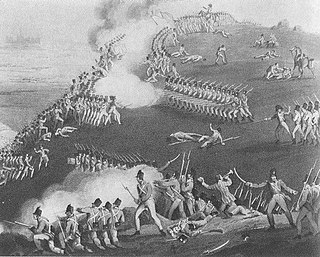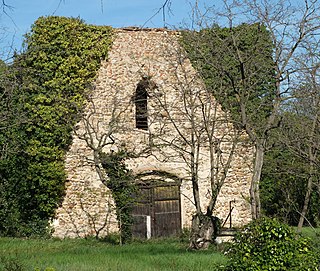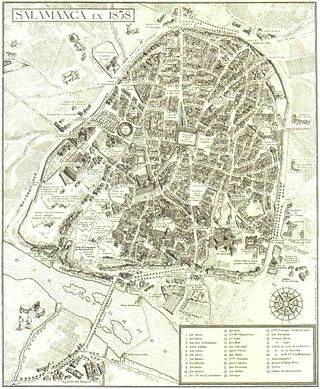
The Battle of Carillon, also known as the 1758 Battle of Ticonderoga, was fought on July 8, 1758, during the French and Indian War. It was fought near Fort Carillon on the shore of Lake Champlain in the frontier area between the British colony of New York and the French colony of New France.

The Battle of Wattignies saw a French army commanded by Jean-Baptiste Jourdan attack a Coalition army directed by Prince Josias of Saxe-Coburg-Saalfeld. After two days of combat Jourdan's troops compelled the Habsburg covering force led by François Sébastien Charles Joseph de Croix, Count of Clerfayt to withdraw. The War of the First Coalition victory allowed the French to raise the siege of Maubeuge. At a time when failed generals were often executed or imprisoned, Jourdan had to endure interference from Lazare Carnot from the Committee of Public Safety. The village, renamed Wattignies-la-Victoire in honor of the important success, is located 9 kilometres (6 mi) southeast of Maubeuge.

The Battle of the Plains of Abraham, also known as the Battle of Quebec, was a pivotal battle in the Seven Years' War. The battle, which began on 13 September 1759, was fought on a plateau by the British Army and Royal Navy against the French Army, just outside the walls of Quebec City on land that was originally owned by a farmer named Abraham Martin, hence the name of the battle. The battle involved fewer than 10,000 troops in total, but proved to be a deciding moment in the conflict between France and Britain over the fate of New France, influencing the later creation of Canada.

The Battle of Neerwinden saw a Republican French army led by Charles François Dumouriez attack a Coalition army commanded by Prince Josias of Saxe-Coburg-Saalfeld. The Coalition army of the Habsburg monarchy together with a small contingent of allied Dutch Republic troops repulsed all French assaults after bitter fighting and Dumouriez conceded defeat, withdrawing from the field. The French position in the Austrian Netherlands swiftly collapsed, ending the threat to the Dutch Republic and allowing Austria to regain control of its lost province. The War of the First Coalition engagement was fought at Neerwinden, located 57 kilometres (35 mi) east of Brussels in present-day Belgium.

Fort Carillon, presently known as Fort Ticonderoga, was constructed by Pierre de Rigaud de Vaudreuil, Governor of New France, to protect Lake Champlain from a British invasion. Situated on the lake some 15 miles (24 km) south of Fort Saint Frédéric, it was built to prevent an attack on Canada and slow the advance of the enemy long enough for reinforcements to arrive.

The Battle of Orthez saw the Anglo-Spanish-Portuguese Army under Field Marshal Arthur Wellesley, Marquess of Wellington attack an Imperial French army led by Marshal Nicolas Soult in southern France. The outnumbered French repelled several Allied assaults on their right flank, but their center and left flank were overcome and Soult was compelled to retreat. At first the withdrawal was conducted in good order, but it eventually ended in a scramble for safety and many French soldiers became prisoners. The engagement occurred near the end of the Peninsular War.

François-Gaston de Lévis, 1st Duke of Lévis, styled as the Chevalier de Lévis until 1785, was a nobleman and a Marshal of France. He served with distinction in the War of the Polish Succession and the War of the Austrian Succession. During the Seven Years' War, he was second-in-command to Louis-Joseph de Montcalm in the defense of New France and then, after the surrender of New France in 1760, he served in Europe. After the war, he was appointed Governor of Artois, and in 1783 he was made a Marshal of France.
The Battle of La Belle-Famille occurred on July 24, 1759, during the French and Indian War along the Niagara River portage trail. François-Marie Le Marchand de Lignery's French relief force for the besieged French garrison at Fort Niagara fell into Eyre Massey's British and Iroquois ambush. This action formed part of the larger Battle of Fort Niagara.

In the Battle of the Bidasoa on 7 October 1813 the Allied army of Arthur Wellesley, Marquess of Wellington wrested a foothold on French soil from Nicolas Soult's French army. The Allied troops overran the French lines behind the Bidassoa River on the coast and along the Pyrenees crest between the Bidasoa and La Rhune (Larrun). The nearest towns to the fighting are Irun on the lower Bidassoa and Bera on the middle Bidasoa. The battle occurred during the Peninsular War, part of the wider Napoleonic Wars.

In the Battle of Castalla on 13 April 1813, an Anglo-Spanish-Sicilian force commanded by Lieutenant General Sir John Murray fought Marshal Louis Gabriel Suchet's French Army of Valencia and Aragon. Murray's troops successfully repelled a series of French attacks on their hilltop position, causing Suchet to retreat. The action took place during the Peninsular War, part of the Napoleonic Wars. Castalla is located 35 kilometers north-northwest of Alicante, Spain.

The Battle of Saguntum saw the Imperial French Army of Aragon under Marshal Louis Gabriel Suchet fighting a Spanish army led by Captain General Joaquín Blake. The Spanish attempt to raise the siege of the Sagunto Castle failed when the French, Italians, and Poles drove their troops off the battlefield in rout. The action took place during the Peninsular War, part of the Napoleonic Wars. Sagunto lies a short distance from the east coast of Spain, about 30 kilometres (19 mi) north of Valencia.

In the Battle of Tordesillas, Battle of Villa Muriel or Battle of Palencia between 25 and 29 October 1812, a French army led by Joseph Souham pushed back an Anglo-Portuguese-Spanish army commanded by Arthur Wellesley, Marquess Wellington. After its failed Siege of Burgos, the 35,000-man Allied army withdrew to the west, pursued by Souham's 53,000 French soldiers. On 23 October, French cavalry defeated the Allied rear guard in the Battle of Venta del Pozo. The Allies pulled back behind the Pisuerga and Carrión Rivers and took up a defensive position.

The Battle of Mas Deu or Battle of Mas d'Eu on 19 May 1793 saw the French Revolutionary Army of the Eastern Pyrenees under Louis-Charles de Flers fighting Bourbon Spain's army of Catalonia led by Antonio Ricardos.
In the Battles of San Millán and Osma two divisions of the Allied army of Arthur Wellesley, Marquess of Wellington clashed with two divisions of King Joseph Bonaparte's Imperial French army in northeast Spain. "extremely punishing couple of miniature battles at Osma and San Millan which ruined Maucune's division and sent the Army of ... There were in fact two armies involved in the campaign of 1813 " "Contact was, however, inevitable and on 18 June there was a sharp fight at the small village of San Millan, when the Light ... The French tried to make a stand at Osma the same day, but this was effortlessly beaten back and with it went .."

The Battle of Tolosa saw a British-Portuguese-Spanish column led by Thomas Graham attempt to cut off a retreating Franco-Italian force under Maximilien Sébastien Foy. Assisted by Antoine Louis Popon de Maucune's division, which fortuitously appeared, the French parried Graham's initial attacks then slipped away when threatened with envelopment. The town of Tolosa is located about 20 kilometres (12 mi) south of San Sebastián. The clash occurred during the Peninsular War, part of the wider Napoleonic Wars.
John Knox was an officer in the British Army who took part in the Austrian War of Succession and the Seven Years' War. He served in North America between 1757 and 1760 and is notable for providing historians with the most complete account of these campaigns. Knox narrowly avoided being killed in 1759 when a French soldier's musket twice misfired, and he went on to fight in the Battle of the Plains of Abraham, where he performed in one of the most devastating volleys in military history. Knox also took part in the Battle of Sainte Foy and was present when Montreal surrendered on 8 September 1760.

The Battle of Pointe-aux-Trembles was a naval and land engagement that took place on 16 May 1760 during the French and Indian War on the north shore of the Saint Lawrence River. It was near the present-day village of Neuville, in New France, during the French siege of Quebec. A relief force of the Royal Navy, having forced a passage through ice up the Saint Lawrence River, destroyed the French ships led by Jean Vauquelin that were assisting in the French siege of Quebec. The British victory forced the French under Chevalier de Lévis to raise the siege and to end their attempts to retake Quebec City.

The siege of the Salamanca forts saw an 800-man Imperial French garrison directed by Lieutenant Colonel Duchemin defend three fortified convents in the city of Salamanca against the 48,000-strong Allied army led by Arthur Wellesley, Lord Wellington. During this time, the French commander Marshal Auguste de Marmont led a 40,000-man French army in an unsuccessful attempt to relieve the garrison. An Allied failure to bring sufficient artillery ammunition caused the siege to be prolonged. The garrison repulsed a premature British attempt to storm the fortified convents on 23 June, but finally surrendered four days later after an artillery bombardment breached one fort and set another one on fire. During his maneuvering, Marmont formed the idea that Wellington was only willing to act on the defensive. This mistaken notion would contribute to Marmont's defeat at the Battle of Salamanca a month later.

The siege of Quebec, also known as the second siege of Quebec, was a French attempt to retake Quebec City, in New France, which had been captured by Britain the previous year. The siege lasted from 29 April to 15 May, when British ships arrived to relieve the city and compelled the French commander, Francis de Gaston, Chevalier de Lévis, to break off the siege and to retreat.

The Montreal campaign, also known as the fall of Montreal, was a British three-pronged offensive against Montreal which took place from July 2 to 8 September 1760 during the French and Indian War as part of the global Seven Years' War. The campaign, pitted against an outnumbered and outsupplied French army, led to the capitulation and occupation of Montreal, the largest remaining city in French Canada.




















